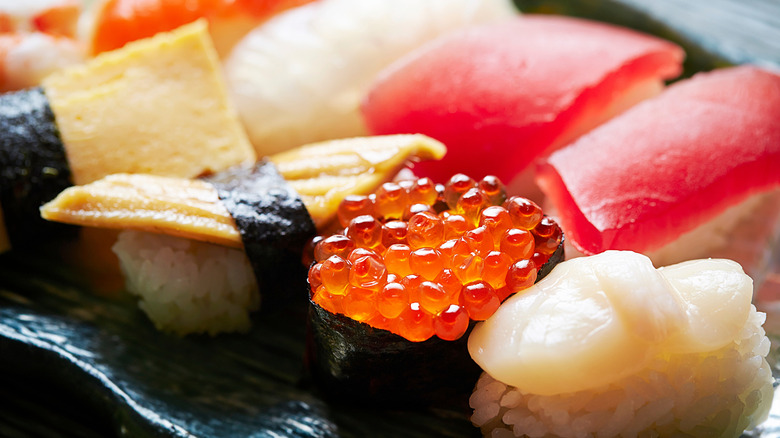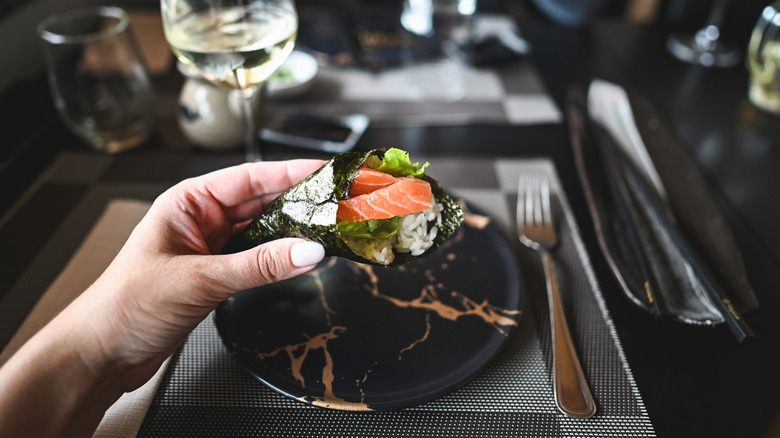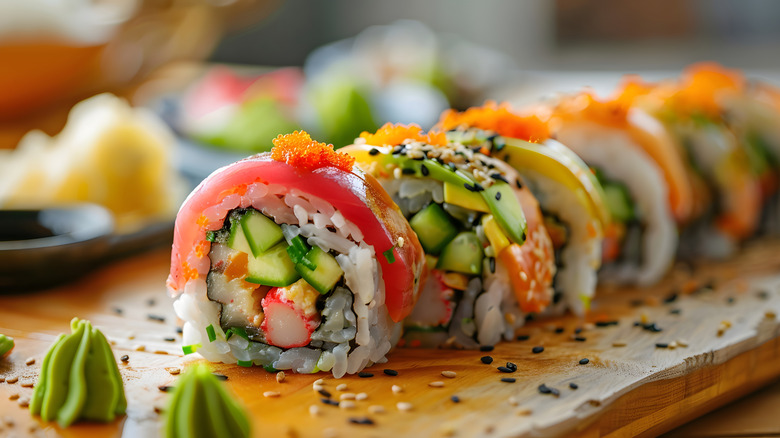Temaki Vs Maki: What Makes These Sushi Rolls Different?
While there are many common types of sushi, temaki and maki refer specifically to the shapes and outer layer of the food. However, even this isn't 100% concrete, so we spoke with Dr. Jae Choi, executive chef and owner of Yakitori Jinbei, to answer our sushi questions.
"Temaki is usually prepared and presented as hand roll, in which the item would fit in your fingers and you could eat it as finger food," Dr. Choi says. "It could be in the shape of a cone, cylindrical, or even a taco shape." No makisu bamboo mats or specialty knives are required for this dish. Instead, sushi chefs expertly manipulate nori like a crepe's wrapping, delicately encompassing the ingredients for convenient consumption.
Maki, however, is more similar to what many people think of as sushi. "Makis are usually made in a log shape and are cut into smaller pieces to enjoy one bite at a time," says Dr. Choi. Requiring a makisu, these are far more difficult to create as they must firmly hold their shape for proper slicing.
What is temaki sushi?
Many Westerners associate sushi with fine dining, but this isn't necessarily true. Temaki, meaning "hand roll," came about during the Edo period and was originally meant for fast, convenient eating. Given that the roll itself requires little skill to create, it was readily, and cheaply, available at many establishments.
Temaki is so simple to create that it's not uncommon to attend temakizushi parties in Japan. Much like Chinese families sitting around and making dumplings or Vietnamese families crafting fresh rolls, these cone-shaped bundles of deliciousness are a fun way to fill everyone's bellies regardless of age or skill level. Unlike maki, temaki may use more cooked ingredients, like smoked salmon or shrimp tempura. While there's nothing stopping you or a chef from adding these ingredients to a maki roll — in fact, this is common throughout the world — the convenience and low cost of temaki make more people feel comfortable with the idea of using cooked seafood.
Like all forms of sushi, temaki lean heavily on vinegar rice and high-quality dark seaweed. These form the base of any temaki's flavor, much like good bread for a hoagie or properly proofed dough for pizza. But as delicious as temaki may be, it's completely different than the classic elegance of a high-quality maki roll.
What is maki sushi?
Maki is the quintessential sushi that many people picture when thinking about Japanese cuisine. Made by laying out rice on large pieces of nori, filling it with seafood and vegetables, then rolling and slicing them, maki requires a certain level of expertise to make perfectly. You can easily make perfectly decent maki at home, but keep in mind that sushi chefs train for years for good reasons.
From preparing the fish to making the rice to rolling and slicing with peerless skill, maki have a wide range of quality, from the tubs you find at the gas station all the way to Sukiyabashi Jiro, one of the best sushi restaurants in the world. Maki is also more reliant on tools than temaki, from knives that look more like a sword to makisu. While the chef's expertise is the most important element of maki, these tools reduce the chances of mistakes and enable absolute perfection.
When talking about the maki sushi rolls, raw fish and vegetables are the most common fillings. However, it really depends on where in the world you are. In America, it might be easy to find crunchy fried crab or avocado, but in Japan, you may only find establishments serving uncooked yellowfin tuna or salmon belly. It's not uncommon to find tamagoyaki, a rolled Japanese omelet, in sushi nowadays, so there's no true limit on what can and cannot be used for good maki.



